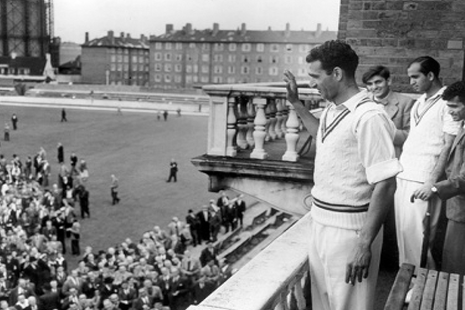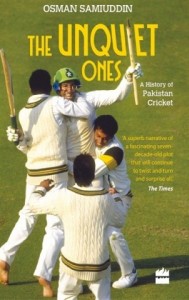The Unquiet Ones, a History of Pakistan Cricket
I was born and brought up close to the Trent Bridge Cricket Ground, Nottingham. When I was nearly 6 years old my father took me to see my first cricket match. It was on 31/8/1974, the very first One Day International played at Trent Bridge, and also the first between England and Pakistan. The elegant Majid Khan made a magnificient 109, Pakistan won by 7 wickets. Since that very day I have been passionate supporter of Pakistan cricketer. As fellow supporters will know this is not an easy task and nerves of steel are required to follow the various highs and lows.
Here I will review Osman Samiuddin’s comprehensive, 510 page compilation, ‘The Unquiet Ones. A History of Cricket in Pakistan’. Osman is an experienced sports writer. Below I will summarise parts of this excellent book, that takes us through a journey of seven decades.
The 31 chapters are split up into 5 parts:
- Section 1 The Arrival
- Section 2 The Regression
- Section 3 The Transformation
- Section 4 The High
- Section 5 The Unravelling
The book opens up by describing the iconic Test match win by Pakistan against England at the Oval in1954. A.H.Kardar was the captain and Fazal Mahmood took 12/99 to seal their victory against the hosts. Pakistan had arrived on the international stage.

The cricketing histories of Minto Park (later Iqbal Park), Government College and Islamia College, Lahore are mentioned, with the political backdrop of the era. A vibrant scene of club cricket played on matted wickets. The early club environment of Karachi is also visited.
Next the birth of the Board of Control for Cricket of Pakistan (BCCP) and the early Pakistan Eaglets tours of the 1950’s are described.
The influence and personality of Oxford don, cricketer and author A.H. Kardar is documented. In 1949 he was the first Pakistani player to play English County cricket, with Warwickshire. His blue eyed team mate, with the lethal leg cutters Fazal Mahmood was the other half of this dynamic duo.
Osman goes on to comment on the infrastructure of cricket development across Pakistan with the construction of stadiums. Together with the early days of cricket commentary and Radio Pakistan.
The discovery and rise of Hanif Mohammad is followed through. His immense concentration and patience became renowned. His epic 337 runs in 999 minutes against the West Indies in 1958, exemplified his personality.
In 1962, another Oxford don 23 year old Javed Burki was appointed as captain for the tour of England. Unfortunately this tour was not successful and Pakistan were easily beaten. The 1960’s were barren years for Pakistan cricket.
The independence of East Pakistan in 1971 caused further political and sporting traumas.
However in the last 1960’s and 1970’s more and more Pakistani players became County cricketers in England. This exposure and associated financial security opened up a new era.
Mushtaq Mohammad, Majid Khan, Sarfraz Nawaz, Zaheer Abbas, Imran Khan, Asif Iqbal, Sadiq Mohammad, Javed Miandad and Intikab Alam all were playing seasons in England. They honed their cricketing skills on a variety of pitches and competed against other international stars. The introduction of TV coverage gave them further popularity.
In 1977 Asif Iqbal was the spokesman for a group of empowered senior players who requested improved financial contracts from A.H. Kardar and the Board. Heated debates took place with even Prime Minister Zulfiqar Ali Bhutto becoming involved to resolve issues. Next came the controversial Kerry Packer revolution taking cricket to a new international level. As a result the Board sent out a weak Pakistan team to an unsuccessful tour England in 1978, without the Kerry Packer ‘rebels’.
Osman Samiuddin describes how once things settled down, Captain Mushtaq Mohammad became an assertive leader on the field, not one to back down from the opposition. How ‘izzat’ (respect) had an impact on performance. Imran Khan blossomed into an attacking fast bowler taking 12 wickets against Australia in Sydney to win the test and draw the series in 1977. The last session of the victorious test was broadcast on TV in Pakistan.
Pakistan was one of the few teams to have the courage to face Australia and the West Indies head on. With the rising popular superstars, came aggression and a fighting attitude. The sport became compulsive viewing in Pakistan. Osman expands on the development of domestic cricket and sponsorships.
This occurred with the back drop of the politics of Zulfiqar Ali Bhutto and General Zia ul Haq.
An interesting chapter is dedicated to major highlight of Pakistan’s cricketing history the World Cup of 1992. Further details are given about the career of Imran Khan. His beginnings as a young cricketer, student, all rounder and captain, then charity fundraiser and inspiring politician.
The arrival of cricket in Sharjah is documented. Javed Miandad’s last ball 6 to beat India has been written into folklore. It gave him an everlasting, legendary, iconic status. Javed’s personality and career moments are charted in a chapter.
The complexities of the Qayyum Commission in 1998, regarding the fixing of games are described together with the individuals involved. PCB politics and finances are also mentioned.
Wasim Akram’s illustrious career is summarised. The long list of Pakistan team captains after Imran Khan are discussed, up until Misbah ul Haq. The long tradition of Pakistan’s association with fast bowling are further explored. The mighty low of the 2010 spot betting scandal is touched upon.
Over the last year we are fortunate to have two substantial classic books published on the history of Pakistan cricket. The first was ‘The Wounded Tiger’ by Peter Oborne (see below) and the second ‘The Unquiet Ones’ by Osman Samiuddin.
Please read; Wounded Tiger, a History of Cricket in Pakistan
The main question is after reading both books which is the best write up of the history of Pakistan cricket??
I think I will leave that up to the readers to make their own judgements!




